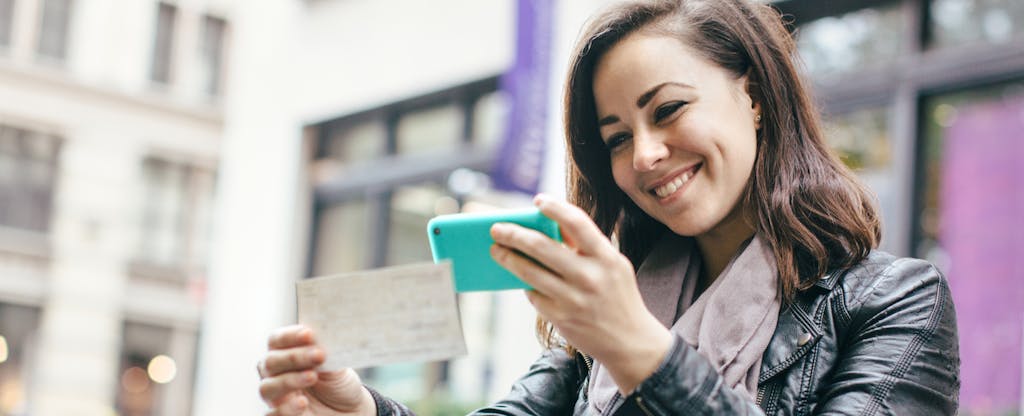In a Nutshell
Depositing a check is pretty simple. You can visit your bank or stop by an ATM, or you may be able to avoid the extra errand by using your mobile device.It takes just a few simple steps to deposit your check at your bank branch or credit union, an ATM, or via your mobile device.
Been handed a check and you’re not sure what to do with it? You can transform that little piece of paper into spending money by either cashing your check or depositing it into a bank account.
If you’d prefer to deposit the funds into a bank account, you’ve got a few options depending on the options available from your bank or credit union. You can go the more traditional route: visiting a physical bank or credit union branch, or stopping by an ATM. Or if you’d rather avoid the extra errand, you may be able to use a mobile banking app on your smartphone or tablet to deposit your check electronically.
Check deposits at the bank
When you deposit a check in person, you’ll be required to endorse the check, which means signing it. It’s pretty simple: On the back of the check, you’ll find two gray lines with a note saying something like “endorse here.” Sign the check on the top line after you’ve arrived at the bank.
In order to complete the transaction, your teller will make sure the check is written out correctly, and may request to see your identification. You’ll also need to provide the account number or account information for the account you want to deposit the check to.
The whole transaction shouldn’t take more than a few minutes, but you’ll have to complete it during banking hours, which often exclude evenings and weekends. You may also want to plan for a possible wait time at the bank.
Once your transaction is complete, typically allow up to two business days before expecting the funds to be available in your account. A portion or all of your check, up to $200, may be funded by the next business day.
Can I deposit part of my check and cash the rest?
Yes, as long as your bank or credit union allows it. When you deposit your check, you can ask your teller to give you cash for part of the check amount and deposit the rest.
Why does the bank place deposits on hold?
A deposit hold is a period of time, usually around two business days, when the bank holds the funds you deposited by check. This delay may seem unnecessary, but it can actually help you. It helps prevent you from spending the money and then having to repay that money if the check turns out to be fraudulent or had to be returned.
Check deposits at an ATM
Depending on your bank or credit union, and the type of ATM, you may be able to deposit your check at an ATM. Just like when you visit a branch, you’ll need to start at an ATM by endorsing the back of the check.
Then you can use your bank-issued debit card to access your account info, follow the prompts for a check deposit, and submit your check directly into the designated slot.
Unlike visiting a bank branch, you can deposit a check into any ATM at any time, as long as the ATM accepts checks. Just like when visiting your branch though, you may still have to wait around two business days before having access to all the funds depending on the amount of the check. In fact, it may take even longer if you deposit the check at an ATM your bank or credit union doesn’t own.
For that reason, it can be beneficial to visit an ATM owned by your bank. Staying in your bank’s network can also be a better choice because it may save you money on ATM fees.
Check deposits with your mobile device
If you’ve got a smartphone or a tablet, and your bank offers the option, you can deposit a check using your mobile banking app, nearly any time and any place. Start by logging into the app, locating the deposit option, and choosing which account you want to deposit the check into.
You’ll probably be asked to take a photo of both sides of your check. If you’re not successful at using the camera right away, helpful hints may pop up on the screen or you may have access to a chat assistant. You may find it easier if you follow these tips.
- Take the photo in a well-lit area
- Place the check on top of a contrasting (dark) surface
- Make sure all four corners of the check can be seen in the frame
Once you’ve taken the photos, be sure to follow any further instructions to complete the deposit. Then review your account activity to make sure the deposited check appears.
Banks may have different time frames for processing mobile deposits — some can be completed as quickly as one business day. But even if the funds from your deposit become available right away, you’ll want to keep the actual paper check for 30 days in case any issues arise with processing. Some banks recommend destroying the check after that.
Bottom line
Regardless of how you choose to deposit your check, be sure to do it right away. There’s no strict rule about when checks expire, but many banks won’t accept a check that’s more than six months past its given date. Plus the longer a check is sitting around, the more likely it could be lost or stolen.
For payments you receive regularly, like your paycheck or other regular check disbursements, consider setting up direct deposit. This paperless option automatically deposits your payments into your account, freeing you up from having to deposit the check yourself. As an added bonus, many banks make payroll funds deposited by direct deposit available immediately.


